2003 DODGE RAM light
[x] Cancel search: lightPage 1877 of 2895
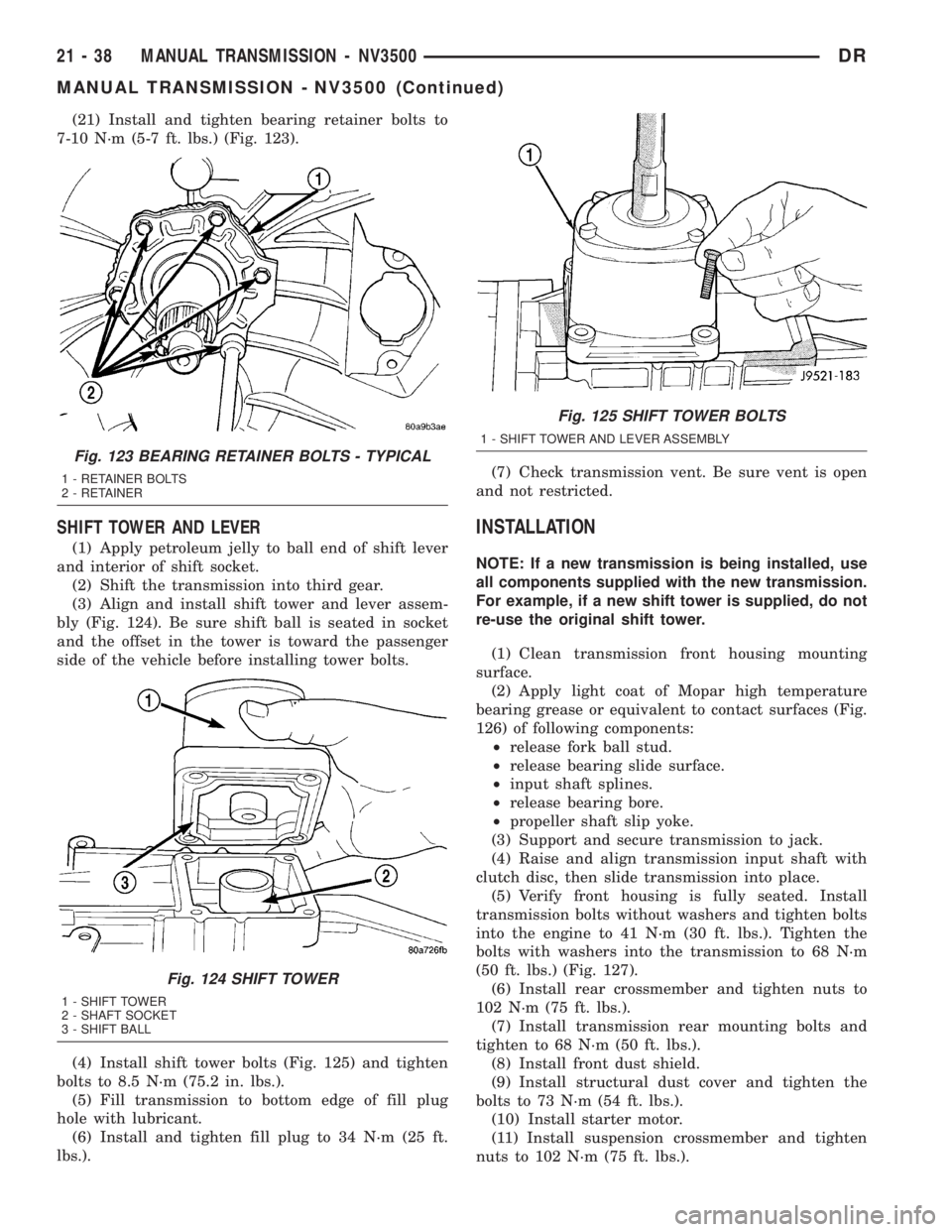
(21) Install and tighten bearing retainer bolts to
7-10 N´m (5-7 ft. lbs.) (Fig. 123).
SHIFT TOWER AND LEVER
(1) Apply petroleum jelly to ball end of shift lever
and interior of shift socket.
(2) Shift the transmission into third gear.
(3) Align and install shift tower and lever assem-
bly (Fig. 124). Be sure shift ball is seated in socket
and the offset in the tower is toward the passenger
side of the vehicle before installing tower bolts.
(4) Install shift tower bolts (Fig. 125) and tighten
bolts to 8.5 N´m (75.2 in. lbs.).
(5) Fill transmission to bottom edge of fill plug
hole with lubricant.
(6) Install and tighten fill plug to 34 N´m (25 ft.
lbs.).(7) Check transmission vent. Be sure vent is open
and not restricted.
INSTALLATION
NOTE: If a new transmission is being installed, use
all components supplied with the new transmission.
For example, if a new shift tower is supplied, do not
re-use the original shift tower.
(1) Clean transmission front housing mounting
surface.
(2) Apply light coat of Mopar high temperature
bearing grease or equivalent to contact surfaces (Fig.
126) of following components:
²release fork ball stud.
²release bearing slide surface.
²input shaft splines.
²release bearing bore.
²propeller shaft slip yoke.
(3) Support and secure transmission to jack.
(4) Raise and align transmission input shaft with
clutch disc, then slide transmission into place.
(5) Verify front housing is fully seated. Install
transmission bolts without washers and tighten bolts
into the engine to 41 N´m (30 ft. lbs.). Tighten the
bolts with washers into the transmission to 68 N´m
(50 ft. lbs.) (Fig. 127).
(6) Install rear crossmember and tighten nuts to
102 N´m (75 ft. lbs.).
(7) Install transmission rear mounting bolts and
tighten to 68 N´m (50 ft. lbs.).
(8) Install front dust shield.
(9) Install structural dust cover and tighten the
bolts to 73 N´m (54 ft. lbs.).
(10) Install starter motor.
(11) Install suspension crossmember and tighten
nuts to 102 N´m (75 ft. lbs.).
Fig. 123 BEARING RETAINER BOLTS - TYPICAL
1 - RETAINER BOLTS
2 - RETAINER
Fig. 124 SHIFT TOWER
1 - SHIFT TOWER
2 - SHAFT SOCKET
3 - SHIFT BALL
Fig. 125 SHIFT TOWER BOLTS
1 - SHIFT TOWER AND LEVER ASSEMBLY
21 - 38 MANUAL TRANSMISSION - NV3500DR
MANUAL TRANSMISSION - NV3500 (Continued)
Page 1882 of 2895
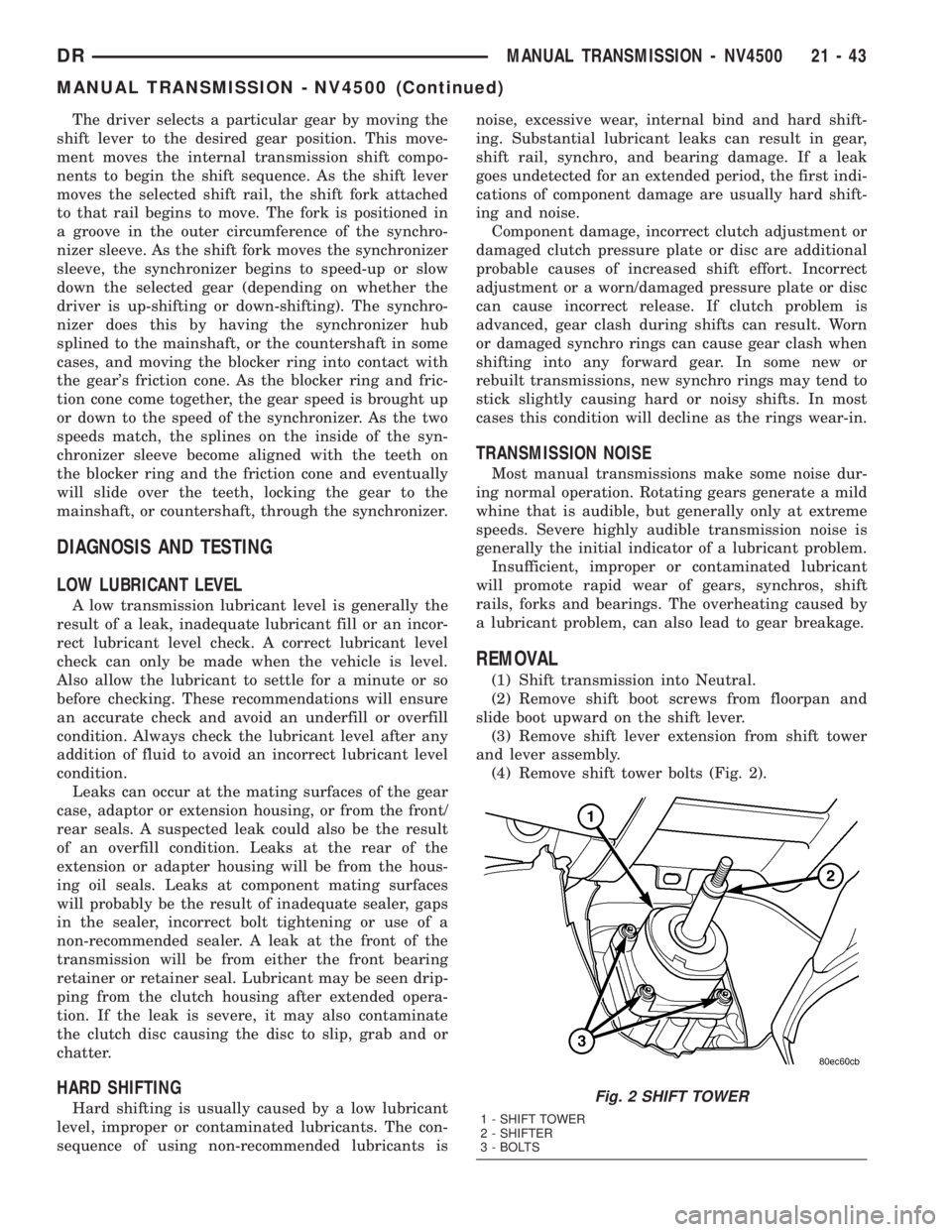
The driver selects a particular gear by moving the
shift lever to the desired gear position. This move-
ment moves the internal transmission shift compo-
nents to begin the shift sequence. As the shift lever
moves the selected shift rail, the shift fork attached
to that rail begins to move. The fork is positioned in
a groove in the outer circumference of the synchro-
nizer sleeve. As the shift fork moves the synchronizer
sleeve, the synchronizer begins to speed-up or slow
down the selected gear (depending on whether the
driver is up-shifting or down-shifting). The synchro-
nizer does this by having the synchronizer hub
splined to the mainshaft, or the countershaft in some
cases, and moving the blocker ring into contact with
the gear's friction cone. As the blocker ring and fric-
tion cone come together, the gear speed is brought up
or down to the speed of the synchronizer. As the two
speeds match, the splines on the inside of the syn-
chronizer sleeve become aligned with the teeth on
the blocker ring and the friction cone and eventually
will slide over the teeth, locking the gear to the
mainshaft, or countershaft, through the synchronizer.
DIAGNOSIS AND TESTING
LOW LUBRICANT LEVEL
A low transmission lubricant level is generally the
result of a leak, inadequate lubricant fill or an incor-
rect lubricant level check. A correct lubricant level
check can only be made when the vehicle is level.
Also allow the lubricant to settle for a minute or so
before checking. These recommendations will ensure
an accurate check and avoid an underfill or overfill
condition. Always check the lubricant level after any
addition of fluid to avoid an incorrect lubricant level
condition.
Leaks can occur at the mating surfaces of the gear
case, adaptor or extension housing, or from the front/
rear seals. A suspected leak could also be the result
of an overfill condition. Leaks at the rear of the
extension or adapter housing will be from the hous-
ing oil seals. Leaks at component mating surfaces
will probably be the result of inadequate sealer, gaps
in the sealer, incorrect bolt tightening or use of a
non-recommended sealer. A leak at the front of the
transmission will be from either the front bearing
retainer or retainer seal. Lubricant may be seen drip-
ping from the clutch housing after extended opera-
tion. If the leak is severe, it may also contaminate
the clutch disc causing the disc to slip, grab and or
chatter.
HARD SHIFTING
Hard shifting is usually caused by a low lubricant
level, improper or contaminated lubricants. The con-
sequence of using non-recommended lubricants isnoise, excessive wear, internal bind and hard shift-
ing. Substantial lubricant leaks can result in gear,
shift rail, synchro, and bearing damage. If a leak
goes undetected for an extended period, the first indi-
cations of component damage are usually hard shift-
ing and noise.
Component damage, incorrect clutch adjustment or
damaged clutch pressure plate or disc are additional
probable causes of increased shift effort. Incorrect
adjustment or a worn/damaged pressure plate or disc
can cause incorrect release. If clutch problem is
advanced, gear clash during shifts can result. Worn
or damaged synchro rings can cause gear clash when
shifting into any forward gear. In some new or
rebuilt transmissions, new synchro rings may tend to
stick slightly causing hard or noisy shifts. In most
cases this condition will decline as the rings wear-in.
TRANSMISSION NOISE
Most manual transmissions make some noise dur-
ing normal operation. Rotating gears generate a mild
whine that is audible, but generally only at extreme
speeds. Severe highly audible transmission noise is
generally the initial indicator of a lubricant problem.
Insufficient, improper or contaminated lubricant
will promote rapid wear of gears, synchros, shift
rails, forks and bearings. The overheating caused by
a lubricant problem, can also lead to gear breakage.
REMOVAL
(1) Shift transmission into Neutral.
(2) Remove shift boot screws from floorpan and
slide boot upward on the shift lever.
(3) Remove shift lever extension from shift tower
and lever assembly.
(4) Remove shift tower bolts (Fig. 2).
Fig. 2 SHIFT TOWER
1 - SHIFT TOWER
2 - SHIFTER
3 - BOLTS
DRMANUAL TRANSMISSION - NV4500 21 - 43
MANUAL TRANSMISSION - NV4500 (Continued)
Page 1883 of 2895
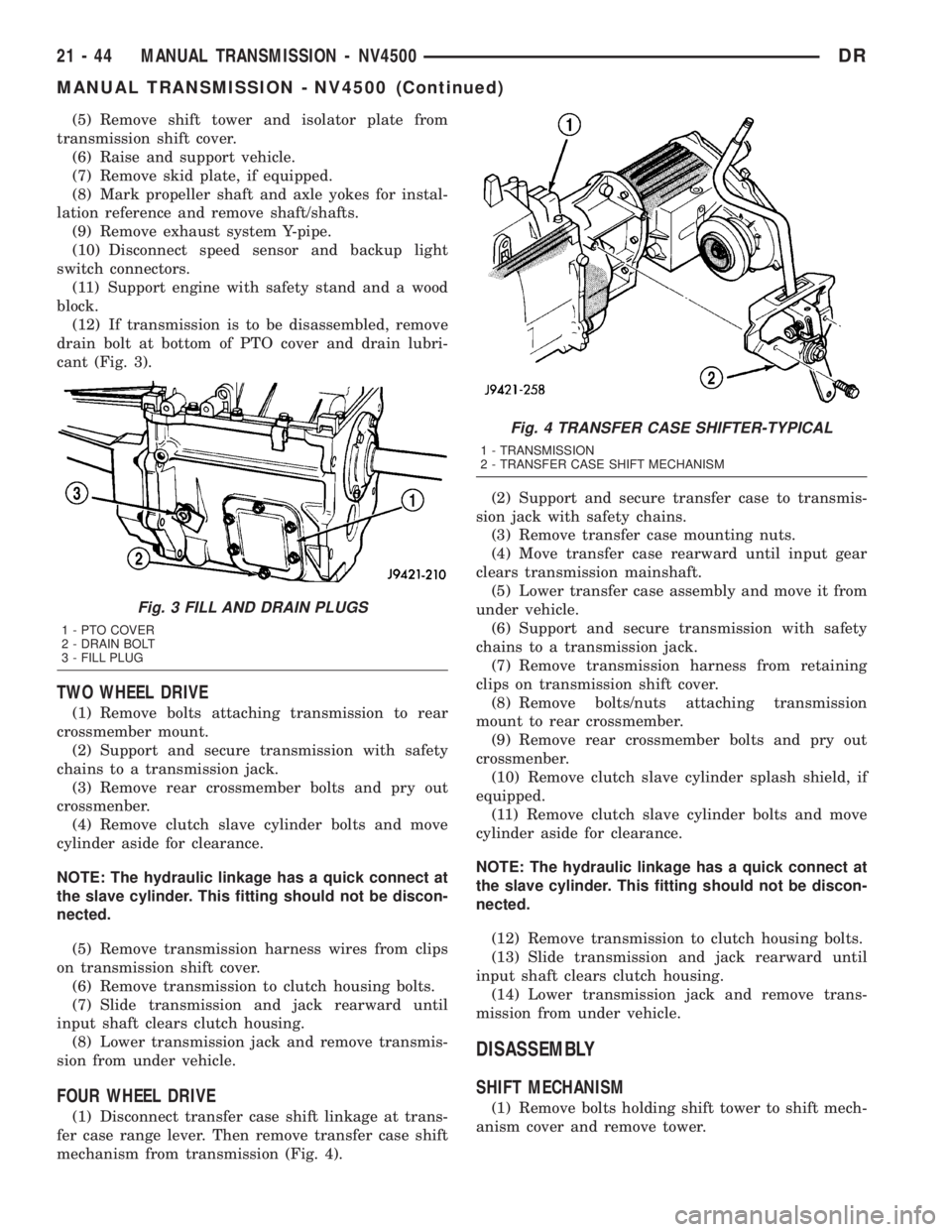
(5) Remove shift tower and isolator plate from
transmission shift cover.
(6) Raise and support vehicle.
(7) Remove skid plate, if equipped.
(8) Mark propeller shaft and axle yokes for instal-
lation reference and remove shaft/shafts.
(9) Remove exhaust system Y-pipe.
(10) Disconnect speed sensor and backup light
switch connectors.
(11) Support engine with safety stand and a wood
block.
(12) If transmission is to be disassembled, remove
drain bolt at bottom of PTO cover and drain lubri-
cant (Fig. 3).
TWO WHEEL DRIVE
(1) Remove bolts attaching transmission to rear
crossmember mount.
(2) Support and secure transmission with safety
chains to a transmission jack.
(3) Remove rear crossmember bolts and pry out
crossmenber.
(4) Remove clutch slave cylinder bolts and move
cylinder aside for clearance.
NOTE: The hydraulic linkage has a quick connect at
the slave cylinder. This fitting should not be discon-
nected.
(5) Remove transmission harness wires from clips
on transmission shift cover.
(6) Remove transmission to clutch housing bolts.
(7) Slide transmission and jack rearward until
input shaft clears clutch housing.
(8) Lower transmission jack and remove transmis-
sion from under vehicle.
FOUR WHEEL DRIVE
(1) Disconnect transfer case shift linkage at trans-
fer case range lever. Then remove transfer case shift
mechanism from transmission (Fig. 4).(2) Support and secure transfer case to transmis-
sion jack with safety chains.
(3) Remove transfer case mounting nuts.
(4) Move transfer case rearward until input gear
clears transmission mainshaft.
(5) Lower transfer case assembly and move it from
under vehicle.
(6) Support and secure transmission with safety
chains to a transmission jack.
(7) Remove transmission harness from retaining
clips on transmission shift cover.
(8) Remove bolts/nuts attaching transmission
mount to rear crossmember.
(9) Remove rear crossmember bolts and pry out
crossmenber.
(10) Remove clutch slave cylinder splash shield, if
equipped.
(11) Remove clutch slave cylinder bolts and move
cylinder aside for clearance.
NOTE: The hydraulic linkage has a quick connect at
the slave cylinder. This fitting should not be discon-
nected.
(12) Remove transmission to clutch housing bolts.
(13) Slide transmission and jack rearward until
input shaft clears clutch housing.
(14) Lower transmission jack and remove trans-
mission from under vehicle.
DISASSEMBLY
SHIFT MECHANISM
(1) Remove bolts holding shift tower to shift mech-
anism cover and remove tower.
Fig. 3 FILL AND DRAIN PLUGS
1 - PTO COVER
2 - DRAIN BOLT
3 - FILL PLUG
Fig. 4 TRANSFER CASE SHIFTER-TYPICAL
1 - TRANSMISSION
2 - TRANSFER CASE SHIFT MECHANISM
21 - 44 MANUAL TRANSMISSION - NV4500DR
MANUAL TRANSMISSION - NV4500 (Continued)
Page 1888 of 2895
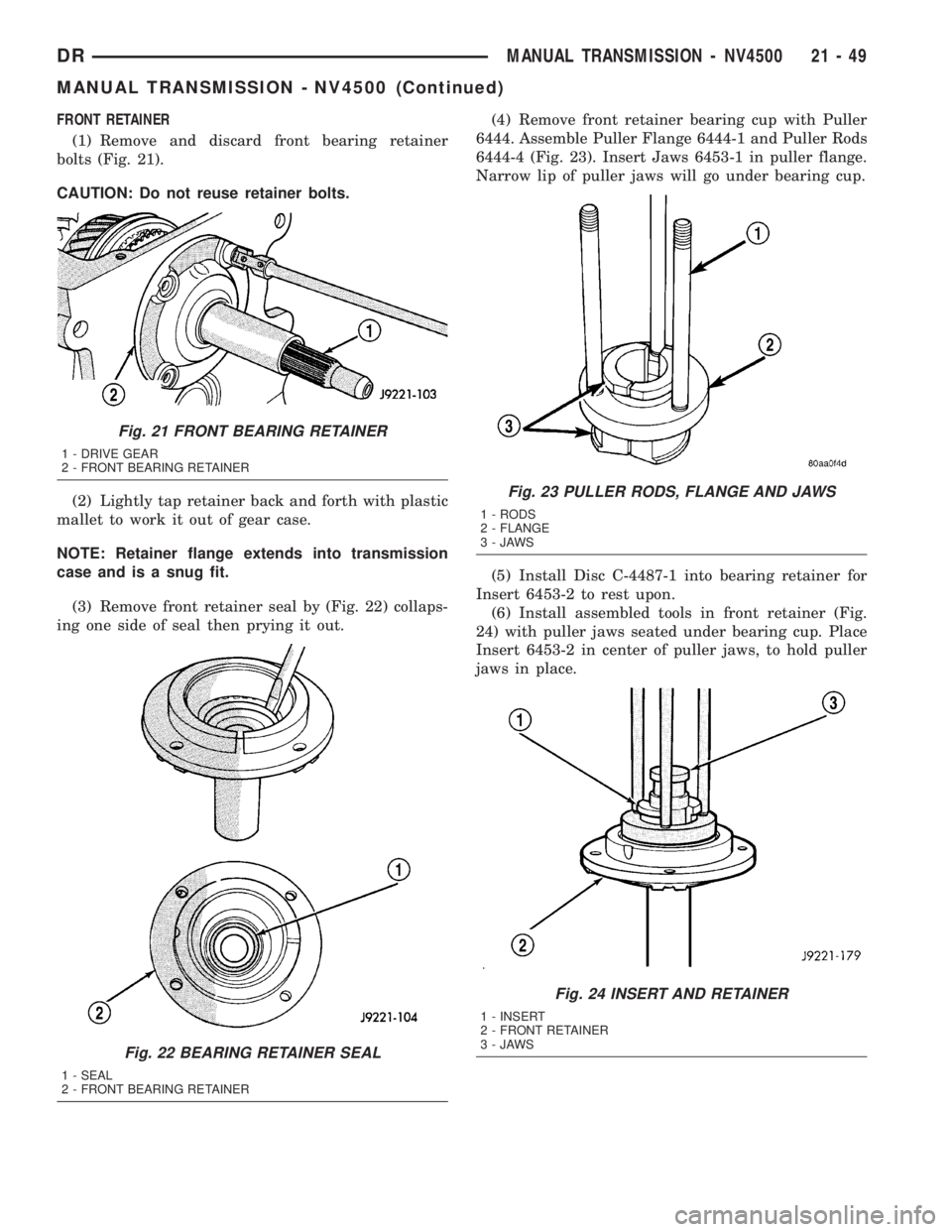
FRONT RETAINER
(1) Remove and discard front bearing retainer
bolts (Fig. 21).
CAUTION: Do not reuse retainer bolts.
(2) Lightly tap retainer back and forth with plastic
mallet to work it out of gear case.
NOTE: Retainer flange extends into transmission
case and is a snug fit.
(3) Remove front retainer seal by (Fig. 22) collaps-
ing one side of seal then prying it out.(4) Remove front retainer bearing cup with Puller
6444. Assemble Puller Flange 6444-1 and Puller Rods
6444-4 (Fig. 23). Insert Jaws 6453-1 in puller flange.
Narrow lip of puller jaws will go under bearing cup.
(5) Install Disc C-4487-1 into bearing retainer for
Insert 6453-2 to rest upon.
(6) Install assembled tools in front retainer (Fig.
24) with puller jaws seated under bearing cup. Place
Insert 6453-2 in center of puller jaws, to hold puller
jaws in place.
Fig. 21 FRONT BEARING RETAINER
1 - DRIVE GEAR
2 - FRONT BEARING RETAINER
Fig. 22 BEARING RETAINER SEAL
1 - SEAL
2 - FRONT BEARING RETAINER
Fig. 23 PULLER RODS, FLANGE AND JAWS
1 - RODS
2 - FLANGE
3-JAWS
Fig. 24 INSERT AND RETAINER
1 - INSERT
2 - FRONT RETAINER
3-JAWS
DRMANUAL TRANSMISSION - NV4500 21 - 49
MANUAL TRANSMISSION - NV4500 (Continued)
Page 1889 of 2895
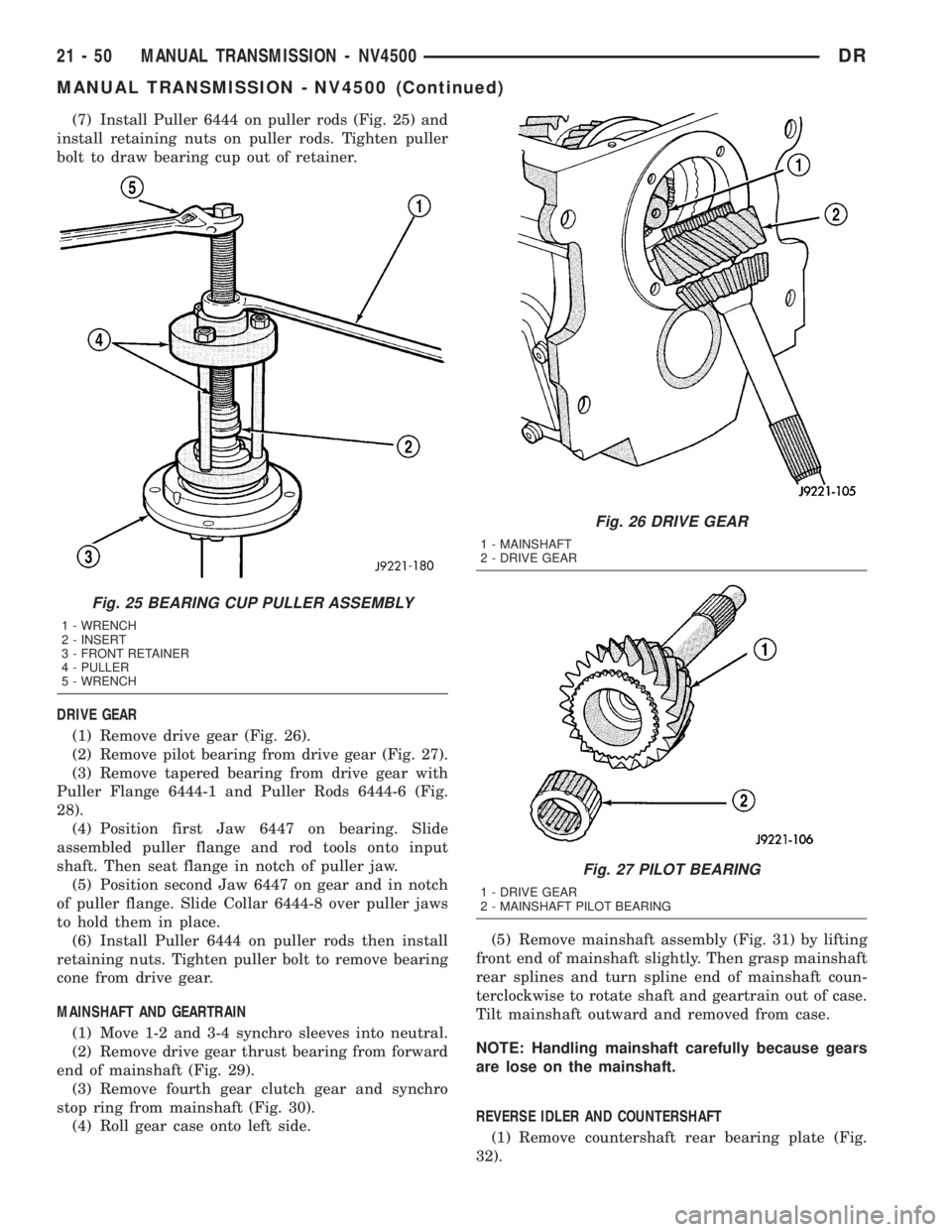
(7) Install Puller 6444 on puller rods (Fig. 25) and
install retaining nuts on puller rods. Tighten puller
bolt to draw bearing cup out of retainer.
DRIVE GEAR
(1) Remove drive gear (Fig. 26).
(2) Remove pilot bearing from drive gear (Fig. 27).
(3) Remove tapered bearing from drive gear with
Puller Flange 6444-1 and Puller Rods 6444-6 (Fig.
28).
(4) Position first Jaw 6447 on bearing. Slide
assembled puller flange and rod tools onto input
shaft. Then seat flange in notch of puller jaw.
(5) Position second Jaw 6447 on gear and in notch
of puller flange. Slide Collar 6444-8 over puller jaws
to hold them in place.
(6) Install Puller 6444 on puller rods then install
retaining nuts. Tighten puller bolt to remove bearing
cone from drive gear.
MAINSHAFT AND GEARTRAIN
(1) Move 1-2 and 3-4 synchro sleeves into neutral.
(2) Remove drive gear thrust bearing from forward
end of mainshaft (Fig. 29).
(3) Remove fourth gear clutch gear and synchro
stop ring from mainshaft (Fig. 30).
(4) Roll gear case onto left side.(5) Remove mainshaft assembly (Fig. 31) by lifting
front end of mainshaft slightly. Then grasp mainshaft
rear splines and turn spline end of mainshaft coun-
terclockwise to rotate shaft and geartrain out of case.
Tilt mainshaft outward and removed from case.
NOTE: Handling mainshaft carefully because gears
are lose on the mainshaft.
REVERSE IDLER AND COUNTERSHAFT
(1) Remove countershaft rear bearing plate (Fig.
32).
Fig. 25 BEARING CUP PULLER ASSEMBLY
1 - WRENCH
2 - INSERT
3 - FRONT RETAINER
4 - PULLER
5 - WRENCH
Fig. 26 DRIVE GEAR
1 - MAINSHAFT
2 - DRIVE GEAR
Fig. 27 PILOT BEARING
1 - DRIVE GEAR
2 - MAINSHAFT PILOT BEARING
21 - 50 MANUAL TRANSMISSION - NV4500DR
MANUAL TRANSMISSION - NV4500 (Continued)
Page 1893 of 2895
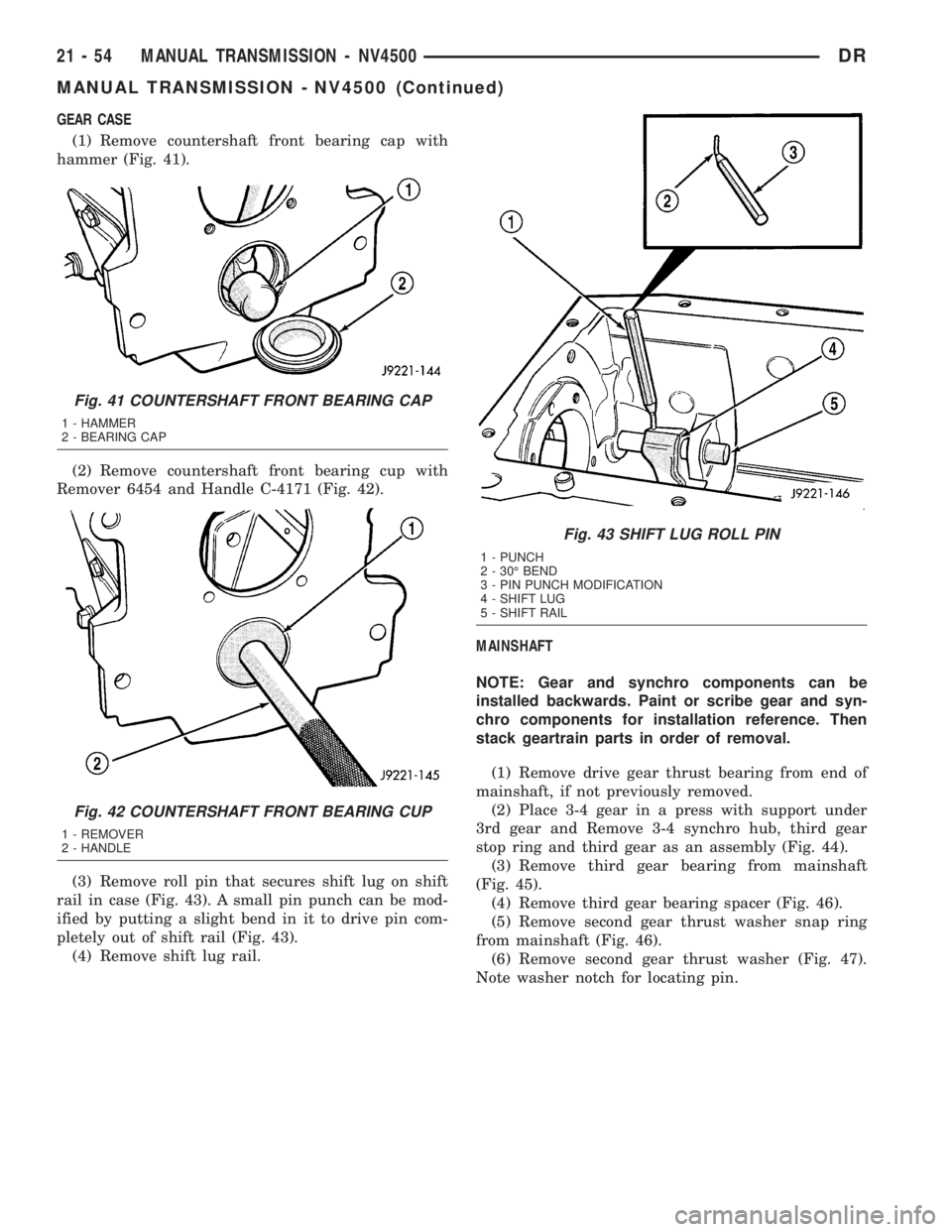
GEAR CASE
(1) Remove countershaft front bearing cap with
hammer (Fig. 41).
(2) Remove countershaft front bearing cup with
Remover 6454 and Handle C-4171 (Fig. 42).
(3) Remove roll pin that secures shift lug on shift
rail in case (Fig. 43). A small pin punch can be mod-
ified by putting a slight bend in it to drive pin com-
pletely out of shift rail (Fig. 43).
(4) Remove shift lug rail.MAINSHAFT
NOTE: Gear and synchro components can be
installed backwards. Paint or scribe gear and syn-
chro components for installation reference. Then
stack geartrain parts in order of removal.
(1) Remove drive gear thrust bearing from end of
mainshaft, if not previously removed.
(2) Place 3-4 gear in a press with support under
3rd gear and Remove 3-4 synchro hub, third gear
stop ring and third gear as an assembly (Fig. 44).
(3) Remove third gear bearing from mainshaft
(Fig. 45).
(4) Remove third gear bearing spacer (Fig. 46).
(5) Remove second gear thrust washer snap ring
from mainshaft (Fig. 46).
(6) Remove second gear thrust washer (Fig. 47).
Note washer notch for locating pin.
Fig. 41 COUNTERSHAFT FRONT BEARING CAP
1 - HAMMER
2 - BEARING CAP
Fig. 42 COUNTERSHAFT FRONT BEARING CUP
1 - REMOVER
2 - HANDLE
Fig. 43 SHIFT LUG ROLL PIN
1 - PUNCH
2 - 30É BEND
3 - PIN PUNCH MODIFICATION
4 - SHIFT LUG
5 - SHIFT RAIL
21 - 54 MANUAL TRANSMISSION - NV4500DR
MANUAL TRANSMISSION - NV4500 (Continued)
Page 1906 of 2895
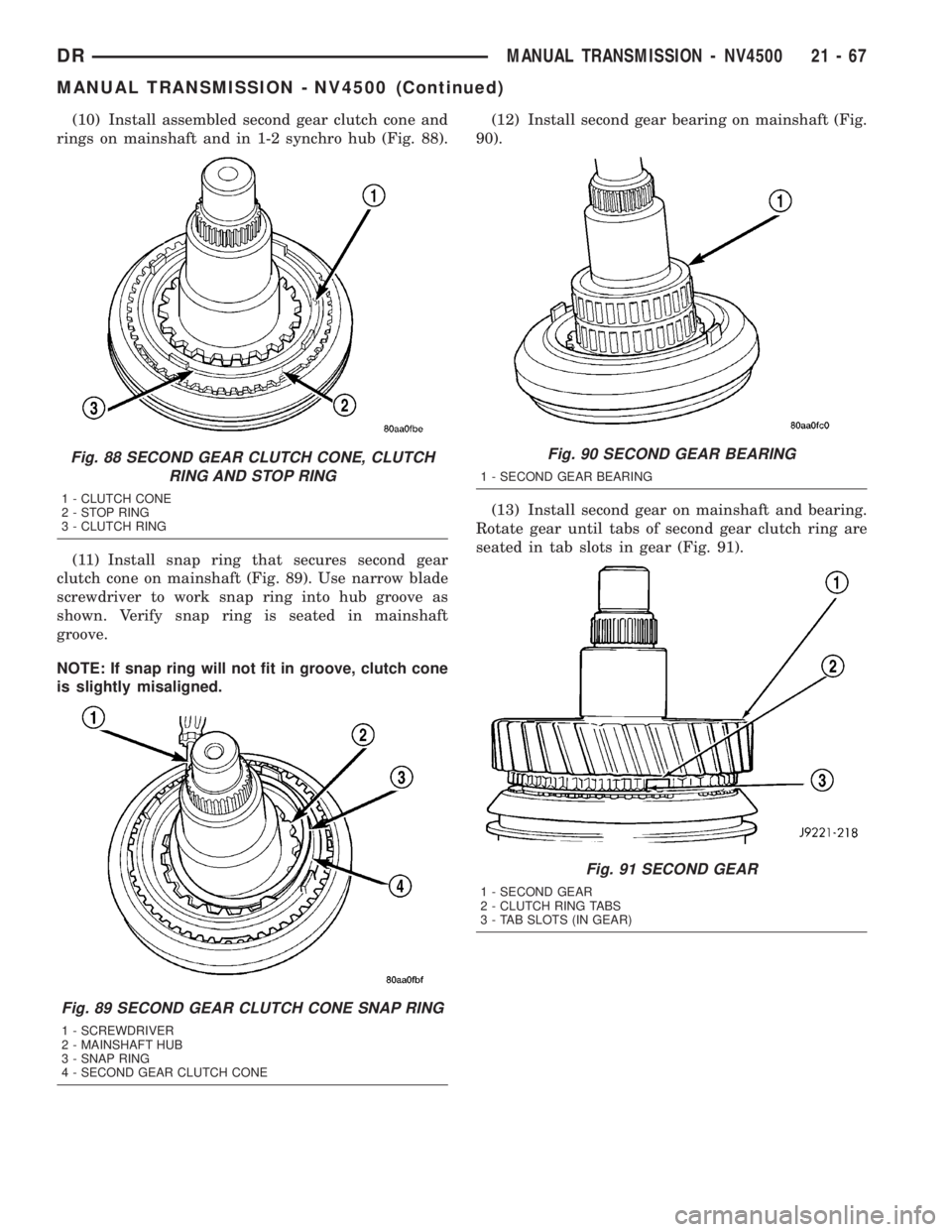
(10) Install assembled second gear clutch cone and
rings on mainshaft and in 1-2 synchro hub (Fig. 88).
(11) Install snap ring that secures second gear
clutch cone on mainshaft (Fig. 89). Use narrow blade
screwdriver to work snap ring into hub groove as
shown. Verify snap ring is seated in mainshaft
groove.
NOTE: If snap ring will not fit in groove, clutch cone
is slightly misaligned.(12) Install second gear bearing on mainshaft (Fig.
90).
(13) Install second gear on mainshaft and bearing.
Rotate gear until tabs of second gear clutch ring are
seated in tab slots in gear (Fig. 91).
Fig. 88 SECOND GEAR CLUTCH CONE, CLUTCH
RING AND STOP RING
1 - CLUTCH CONE
2 - STOP RING
3 - CLUTCH RING
Fig. 89 SECOND GEAR CLUTCH CONE SNAP RING
1 - SCREWDRIVER
2 - MAINSHAFT HUB
3 - SNAP RING
4 - SECOND GEAR CLUTCH CONE
Fig. 90 SECOND GEAR BEARING
1 - SECOND GEAR BEARING
Fig. 91 SECOND GEAR
1 - SECOND GEAR
2 - CLUTCH RING TABS
3 - TAB SLOTS (IN GEAR)
DRMANUAL TRANSMISSION - NV4500 21 - 67
MANUAL TRANSMISSION - NV4500 (Continued)
Page 1910 of 2895

(e) Install second and third struts in same man-
ner as described in step (d).
(f) Work sleeve upward on hub until struts are
centered and seated in sleeve. Sleeve should be in
neutral position after seating struts.
(34) Install reverse gear and synchro assembly on
mainshaft (Fig. 104). Rotate assembly until stop ring
lugs engage in hub slots and gear drops into seated
position.
(35) Install reverse gear thrust washer (Fig. 105).
(36) Install rear bearing on mainshaft with
Installer 6446. Seat bearing on output shaft and
against thrust washer (Fig. 106).
(37) Install fourth gear stop ring in 3-4 synchro
sleeve (Fig. 107).
(38) Install fourth gear clutch gear in stop ring
(Fig. 108).
(39) Roll gear case onto its left side.
(40) Grip mainshaft at pilot bearing hub and just
behind reverse gear. Then lift assembly and guide
rear of shaft through bearing bore at rear of case.
(41) Continue holding front of shaft but switch
grip at rear to shaft output splines. Lift mainshaft
assembly slightly, align gears and seat assembly in
case.
Fig. 104 REVERSE GEAR
1 - REVERSE GEAR AND SYNCHRO ASSEMBLY
Fig. 105 REVERSE GEAR THRUST WASHER
1 - THRUST WASHER
2 - REVERSE GEAR
Fig. 106 MAINSHAFT REAR BEARING
1 - INSTALLER
2 - MAINSHAFT REAR BEARING
Fig. 107 FOURTH GEAR STOP RING
1 - 3-4 SYNCHRO SLEEVE
2 - FOURTH SPEED STOP RING
Fig. 108 FOURTH GEAR CLUTCH GEAR
1 - FOURTH SPEED CLUTCH GEAR
DRMANUAL TRANSMISSION - NV4500 21 - 71
MANUAL TRANSMISSION - NV4500 (Continued)